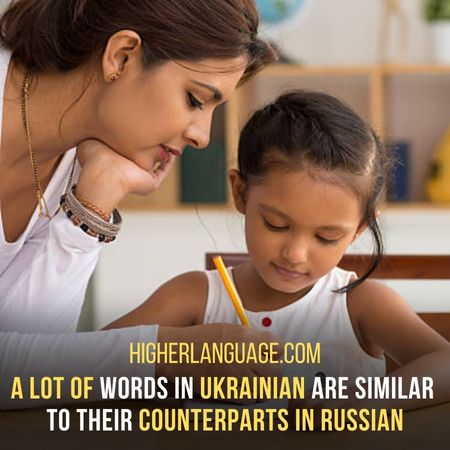Many people do not know that there are many languages similar to Ukrainian? Interestingly, Ukrainian belongs to the East Slavic languages. Thus, Belarusian, Russian, Polish, etc., are close to it.
[toc]
All these languages share many common features. So, if you know one of them, it will be much easier for you to learn the others.
Languages Similar To Ukrainian – 8 Languages!
Ukrainian is the official language of Ukraine. It is a language that approximately 40 million people speak worldwide.
Further, it is one of the most widely spoken languages, which belongs to the Slavic family.
Some languages similar to Ukrainian include Russian, Belarusian, Polish, and Czech. In addition, languages like Bulgarian, Slovak, and Slovenian are also found to be quite similar to Ukrainian.
These languages share many similarities in terms of grammar, pronunciation, and vocabulary. Thus, learning similar languages is relatively easier.
So if you already speak one of these languages, it would be easy to pick up another!
If you want to learn more about languages related to Ukrainian, go ahead and give them a try! You’ll be pleasantly surprised at how quickly you can learn!
Now, it’s time to find out about languages similar to Ukrainian.
1. Russian And Ukrainian Have Common Vocabulary:
Russian is the language of people living in Eastern Europe and Northern Asia. It’s the official language of Russia, and it’s also widely spoken in Ukraine.
Ukrainian and Russian are two different languages. However, there are many similarities between them in terms of vocabulary.
A lot of words in Ukrainian are similar to their counterparts in Russian.

For example, some common words like “вода” (water), “гора” (mountain), and “дім” (house) are the same in both languages.
This is because the two languages share a common history. So, they have had an influence on each other for many years.
As a result, speakers of Ukrainian and Russian can often understand each other easily. They can still manage even if they can’t speak each other’s language fluently.
2. Belarusian Is Gender-Biased Like Ukrainian:
Languages, like many things in our world, may have gender. They are often seen as belonging to either masculine or feminine domains.
This is common in the way that languages treat genders of nouns, pronouns, and even verbs. For example, in English, “he” is for masculine nouns, while “she” is for feminine nouns.
Belarusian and Ukrainian are two languages that take this gendering a step further.
These languages have gendered pronouns. Also, they use verb conjugations to match the gender of the subject.
As a result, conversation in these languages tends to be very gendered. While this may seem like a small thing, it can have a big impact on how people interact with each other.
Languages are increasingly becoming more gender-neutral. Yet, Belarusian and Ukrainian stand out as being distinctly gendered.
3. Polish Share Grammatical Rules:
It’s often said that languages spoken in neighboring countries are quite similar. This is certainly the case for Polish and Ukrainian.
Both languages are Slavic languages, which means they share a lot of common features.

For example, both languages have similar verb tenses. This means a speaker must use different verb forms depending on who is doing the action and when.
This can be tricky to pick up, but it’s not impossible. Especially if you know one, it’s much easier to pick up the other.
In addition, noun declensions and aspect markers are common in both languages. In Ukrainian, nouns change depending on their role in the sentence.
For example, the ending of a noun can change to denote gender, case, or number. This is also true for Polish.
Thus, these two languages are similar in many ways. This helps make learning one language easier if you already know the other.
4. Rusyn Also Has Linguistic Gender Interference:
Rusyn is a common language in Eastern European countries, including Ukraine and Poland. Rusyn and Ukrainian are similar, belonging to the Slavic language family.
Rusyn is a dialect of Ukrainian, and both languages are mutually intelligible. This means that a person who speaks one language can understand what is said in the other.
Rusyn also uses similar grammar rules to Ukrainian. For instance, nouns are masculine, feminine, and neutered in the gender category.
Such as, in Ukrainian and Rusyn, feminine gender nouns usually end in -a, such as in мама (mom). At the same time, masculine gender nouns usually end with -o, such as in батько (father).
Further, both languages share a similar alphabet. Moreover, the languages have loanwords from different languages, such as Polish, Hungarian and Russian.
The Slavic heritage is significant for both languages. Therefore, they share more similarities than other dialects.
5. Surzhyk Is Close To Ukrainian:
Surzhyk is a hybrid language of Ukrainian and Russian languages. It is widely spoken in Ukraine, especially in the Kharkiv and Donetsk regions.
Many of the words used in Surzhyk come from these languages. The reason is it is a mix of Ukrainian and Russian pronunciations.
For example, the Ukrainian word for ‘girl’ is дівчина(divchyna). While the Russian word is девушка(devushka)
Here, people in Surzhyk also say девушка (devushka). As you can see, pronunciation may differ, but style and meaning are similar.
For anyone who’s ever tried to learn a foreign language, the similarities between languages can help.
So, sharing features with a language you already know can make picking up the new language easier. For speakers of Ukrainian, Surzhyk offers many advantages.
Like Ukrainian, Surzhyk is a Slavic language with roots in Old Church Slavonic. Thus, this can make it easier for speakers of Ukrainian to learn Surzhyk.
6. Slovak Also Use Genitive Case:
When people think of Slavic languages, they often think of Russian and Polish. However, Slovak is also a Slavic language spoken in Central and Eastern Europe.
Like other Slavic languages, Slovak is very similar to Ukrainian in terms of grammar.
In fact, many experts believe that Ukrainian is more closely related to Slovak than it is to Russian. This is because both languages share several features.

Like, the use of the genitive case. The genitive case is a grammatical case that indicates possession.
For example, the word for “my” in Ukrainian is miy, which is in the genitive case. In Slovak, the same word is moj, also in the genitive case.
For instance, a sentence like “I saw my friend” in Ukrainian would be “Ya vidiy moyoho druha”. While the same sentence in Slovak would be “Videl som svojho priatela.”
As you can see, both languages use the genitive case to indicate possession.
7. Czech Also Rely On Prefix/Suffix Like Ukrainian:
The Czech and Ukrainian languages share many grammar rules. This is not surprising, given their similarities. In addition, both are Slavic languages, which means they share a common ancestor.
In addition, Czech and Ukrainian are both inflected languages. This means words undergo changes in spelling or pronunciation to indicate grammatical function.
For example, the Czech word for “book” is kniha, but the plural form is knihy. Likewise, the Ukrainian word for “girl” is divchyna, but the plural form is divchyntsi.
In addition, they have a rich system of prefixes and suffixes.
For example, in Ukrainian, the prefix під- can create words that have meanings like “under” or “below”. Also, adding the prefix po- to a word can mean “around” or “through”.
Further, both languages also have similar vowel harmony. This means the vowels in a given word must agree with one another.
Czech and Ukrainian are similar. Speakers of each language can often easily understand the other. So if you’re ever looking for a language to learn that’s similar to Ukrainian, Czech is a good option.
8. Bulgarian And Ukrainian Have Some Commonalities:
While Ukrainian and Bulgarian may not be languages typically considered similar. However, there are many similarities between the two.
For one, both languages are descended from the Slavic languages. This means they share a number of commonalities in terms of grammar and vocabulary.
Additionally, both languages use the Cyrillic alphabet. It makes them seem even more similar at first glance.

Another similarity between Ukrainian and Bulgarian is a common region. These languages are common in countries in the former Soviet Union.
This means a certain degree of shared cultural experience. This makes it easier for speakers of either language to understand the other easily.
Finally, another similarity between Ukrainian and Bulgarian is their status. Both are minority languages in Europe.
So, in this sense, these two languages have become increasingly intertwined and connected.
Conclusion:
There are many languages similar to Ukrainian. Some of these languages include Russian, Belarusian, and Polish.
In addition, Slovak, Bulgarian, Rusyn, Surzhyk, and Czech are good choices. All the languages share some similarities with Ukrainian.
This is helpful if you want to learn a language similar to Ukrainian. This will help you understand the basics quickly.
Learning languages similar to Ukrainian for better communication can also be beneficial. By doing so, you can interact with people who speak languages other than Ukrainian. So, just give it a try!